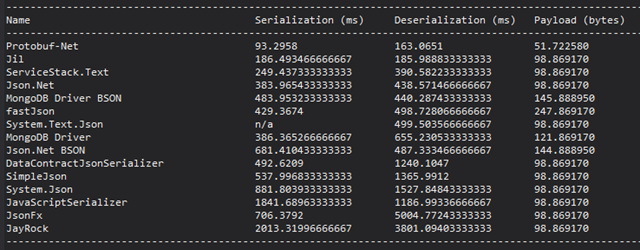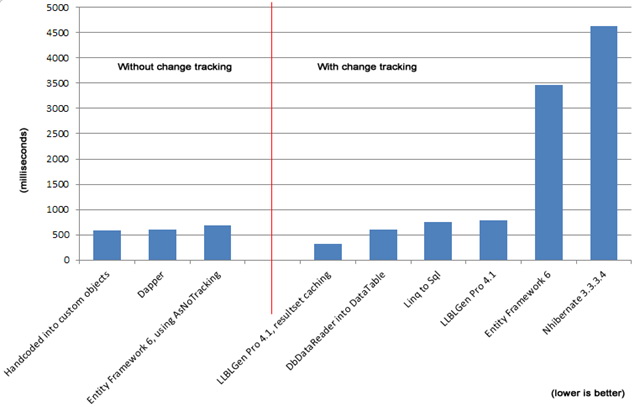8 Ways to Improve ASP.NET Web API Performance
ASP.NET Web API is a great technology. Writing Web APIs is so easy that many developers don't spend time structuring their applications to achieve good performance.
In this article, I will introduce 8 techniques to improve the performance of ASP.NET Web API.
1) Use the fastest JSON serialization tool
JSON serialization has a critical impact on the performance of the entire ASP.NET Web API. On one of my projects, I switched from JSON.NET serialization tool to ServiceStack.Text for a year and a half.
I have measured that the performance of Web API has increased by about 20%. I strongly recommend you to try this serialization tool. Here is some recent comparative data on the performance of popular serialization tools.

Source: theburningmonk
Update: It seems that It seems that StackOverflow is using Jil, which they claim is the fastest JSON serialization tool to date. A test data can be found on their GitHub page Jil serializer.
2) Manual serialization of JSON from DataReader
I have used this method in my projects and obtained the performance benefits.
You can manually create JSON strings from DataReader and avoid unnecessary object creation, so you don't have to take values from DataReader and write objects, then take values from these objects and use JSON Serializer to generate JSON.
Use StringBuilder to produce JSON and return StringContent at the end as the content of the response in WebAPI.
var response = Request.CreateResponse(HttpStatusCode.OK); response.Content = new StringContent(jsonResult, Encoding.UTF8, "application/json"); return response;
You can check out more methods at Rick Strahl's blog
3) Use other protocol formats (protocol buffer, message pack) as much as possible
If you can use other message formats in your project, such as Protocol Buffers or MessagePack instead of using the JSON protocol format.
You will get huge performance advantages, not only because the serialization of Protocol Buffers is very fast, but also the formatting of the returned results is faster than JSON.
4) Implement compression
Use GZIP or Deflate in your ASP.NET Web API.
Compression is a simple and effective way to reduce response packet size and response speed.
This is a very necessary feature to use, you can view more articles about compression in my blog ASP.NET Web API GZip compression ActionFilter with 8 lines of code.
5) Using caching
in Web API The use of output caching in this method has profound implications. For example, if a large number of users access the same response content that only changes once a day.
If you want to implement manual caching, such as caching user passwords in memory, please refer to my blog post Simple way to implement caching in ASP.NET Web API.
6) Use typical ADO.NET as much as possible
Manual Writing in ADO.NET is still the fastest way to get values from a database. If Web API performance is really important to you, then don't use ORMs.
You can see a performance comparison between the most popular ORMs.

Dapper 和hand-written fetch code 很快,果不其然,所有的ORM都比这三种慢.
带有resultset缓存的LLBLGen 很快,但它要重新遍历一遍resultset并重新再内存中实例化对象。
7)在 Web API 中实现异步方法
使用异步的 Web API 服务大幅增加 Web API 对于Http 请求的处理数量。
实现是简单的,只需使用 async 的关键字和 将你方法的返回值类型改为 Task 即可。
[HttpGet]
public async Task OperationAsync()
{
await Task.Delay(2000);
}8) 返回多个结果集和集合的组合
减少传输的次数不仅多数据库有好处,对于 Web API同样 ,你才有可能使用结果集的功能。
也就是说你可以从DataReader去提取多个结果集 参见以下演示代码:
// read the first resultset
var reader = command.ExecuteReader();
// read the data from that resultset
while (reader.Read())
{
suppliers.Add(PopulateSupplierFromIDataReader( reader ));
}
// read the next resultset
reader.NextResult();
// read the data from that second resultset
while (reader.Read())
{
products.Add(PopulateProductFromIDataReader( reader ));
}你可以在一个 Web API 的一次响应中返回多个对象,试着将你的返回的多个对象进行组合后返回 如下:
public class AggregateResult
{
public long MaxId { get; set; }
public List<Folder> Folders{ get; set; }
public List<User> Users{ get; set; }
}这种方式将减少对你的WEB API的HTTP请求。

Hot AI Tools

Undresser.AI Undress
AI-powered app for creating realistic nude photos

AI Clothes Remover
Online AI tool for removing clothes from photos.

Undress AI Tool
Undress images for free

Clothoff.io
AI clothes remover

AI Hentai Generator
Generate AI Hentai for free.

Hot Article

Hot Tools

Notepad++7.3.1
Easy-to-use and free code editor

SublimeText3 Chinese version
Chinese version, very easy to use

Zend Studio 13.0.1
Powerful PHP integrated development environment

Dreamweaver CS6
Visual web development tools

SublimeText3 Mac version
God-level code editing software (SublimeText3)

Hot Topics
 What are the alternatives to NULL in C language
Mar 03, 2025 pm 05:37 PM
What are the alternatives to NULL in C language
Mar 03, 2025 pm 05:37 PM
This article explores the challenges of NULL pointer dereferences in C. It argues that the problem isn't NULL itself, but its misuse. The article details best practices for preventing dereferences, including pre-dereference checks, pointer initiali
 Which C language compiler is better?
Mar 03, 2025 pm 05:39 PM
Which C language compiler is better?
Mar 03, 2025 pm 05:39 PM
This article guides beginners on choosing a C compiler. It argues that GCC, due to its ease of use, wide availability, and extensive resources, is best for beginners. However, it also compares GCC, Clang, MSVC, and TCC, highlighting their differenc
 How to add next-level C compiler
Mar 03, 2025 pm 05:44 PM
How to add next-level C compiler
Mar 03, 2025 pm 05:44 PM
This article explains how to create newline characters in C using the \n escape sequence within printf and puts functions. It details the functionality and provides code examples demonstrating its use for line breaks in output.
 Is NULL still important in modern programming in C language?
Mar 03, 2025 pm 05:35 PM
Is NULL still important in modern programming in C language?
Mar 03, 2025 pm 05:35 PM
This article emphasizes the continued importance of NULL in modern C programming. Despite advancements, NULL remains crucial for explicit pointer management, preventing segmentation faults by marking the absence of a valid memory address. Best prac
 What are the web versions of C language compilers?
Mar 03, 2025 pm 05:42 PM
What are the web versions of C language compilers?
Mar 03, 2025 pm 05:42 PM
This article reviews online C compilers for beginners, focusing on ease of use and debugging capabilities. OnlineGDB and Repl.it are highlighted for their user-friendly interfaces and helpful debugging tools. Other options like Programiz and Compil
 C language online programming website C language compiler official website summary
Mar 03, 2025 pm 05:41 PM
C language online programming website C language compiler official website summary
Mar 03, 2025 pm 05:41 PM
This article compares online C programming platforms, highlighting differences in features like debugging tools, IDE functionality, standard compliance, and memory/execution limits. It argues that the "best" platform depends on user needs,
 Method of copying code by C language compiler
Mar 03, 2025 pm 05:43 PM
Method of copying code by C language compiler
Mar 03, 2025 pm 05:43 PM
This article discusses efficient code copying in C IDEs. It emphasizes that copying is an IDE function, not a compiler feature, and details strategies for improved efficiency, including using IDE selection tools, code folding, search/replace, templa
 How to solve the problem of not popping up the output window by the C language compiler
Mar 03, 2025 pm 05:40 PM
How to solve the problem of not popping up the output window by the C language compiler
Mar 03, 2025 pm 05:40 PM
This article troubleshoots missing output windows in C program compilation. It examines causes like failing to run the executable, program errors, incorrect compiler settings, background processes, and rapid program termination. Solutions involve ch






